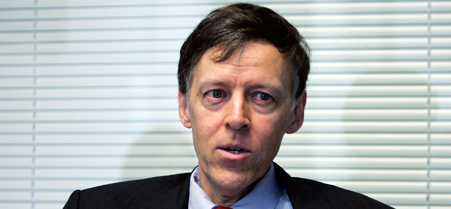Security expert: Obama order resembles controversial Bush-era data-mining tool
Memo issued in January to upgrade IT to integrate databases and correlate information after Christmas Day bombing attempt is similar to a 2002 DARPA project that attracted intense public opposition.
 Robert Atkinson, president of the Information Technology and Innovation Foundation, said few people would even contemplate the Total Information Awareness system again.
Robert Atkinson, president of the Information Technology and Innovation Foundation, said few people would even contemplate the Total Information Awareness system again.
The Obama administration has called for the development of a computer network that one security expert said on Tuesday resembles a controversial system that President Bush initiated after the 9/11 terrorist attacks, which was eventually abandoned due to public outcry over invasions of privacy.
In 2002, under the leadership of John Poindexter, former national security adviser to President Reagan, the Defense Department began building the Total Information Awareness system to discover, combine and filter information that may flag incidents indicating terrorist activities. Defense envisioned a program that would probe private databases, including those containing Americans' personal credit card accounts, medical data and cell phone records.
The system, which the Defense Advanced Research Projects Agency oversaw, later was renamed the Terrorism Information Awareness program to make it seem less threatening. TIA effectively was killed when Congress refused to fund parts of the program for fiscal 2004 because citizens viewed it as an encroachment on their privacy.
TIA resembles an initiative President Obama called for after the failed attempt to bring down a Detroit-bound jet on Christmas Day, said K. A. Taipale, executive director of the Stilwell Center for Advanced Studies in Science and Technology Policy and a member of the Markle Foundation Task Force on National Security in the Information Age. He revived talk of such a system at a discussion in Washington on using information technology that can make relationships among huge amounts of personal information worldwide to prevent another homeland security disaster.
"The name may have scared a lot of people but the programs were directly addressed at solving some of these problems," Taipale said at the Tuesday event, hosted by the Information Technology and Innovation Foundation, a nonprofit think tank.
He said the system is similar to what Obama called for in a January memo regarding the failed bombing attack in December. The president ordered the director of national intelligence to clarify the role of counterterrorism analytics in "synchronizing, correlating and analyzing all sources of intelligence related to terrorism" and expedite IT upgrades to improve "knowledge discovery, database integration, cross-database searches, and the ability to correlate biographic information with terrorism-related intelligence."
Obama's agenda closely matches the technical approach to TIA, Taipale said. That section "was the initiating idea and business purpose statement of TIA -- Total Information Awareness," he added. "This is the stuff we started many years ago and just haven't followed through."
According to DARPA's Web site , the TIA system focused on the development of "a large-scale counterterrorism database"; the invention of "new algorithms for mining, combining and refining information for subsequent inclusion into the database"; and "revolutionary new models, algorithms, methods, tools and techniques for analyzing and correlating information in the database to derive actionable intelligence."
Concerns that TIA would be used to persecute citizens prompted Congress to limit funding to include only processing, analysis and collaboration tools that assist counterterrorism foreign intelligence. Robert Atkinson, the foundation's president and also a member of Markle's task force, noted that the program was eliminated in a manner that discouraged anyone from even contemplating such a system again.
"TIA was the DARPA-funded project to work on the tools to solve these problems, and TIA got killed because all those editorials and the privacy lobby turned it into a collection program," Taipale said. "Now we're 10 years later, and we don't have the tools."
Chris Tucker, the founding chief strategic officer of the CIA's venture capital firm In-Q-Tel, acknowledged that the name of the program was bad branding. But "the key thing is it was good information management, good data management," he said. "Whether the enterprise is asking the right questions or the wrong questions is a different issue."
Tucker also urged greater funding for spatial technology, the equipment for tracking the practice of tracking information across space and time.
"When you connect the dots, you're connecting dots on a map, literally, a geographic map," said Tucker, now a principal at Yale House Ventures, a portfolio of social initiatives and technology companies. "And it's something we do not do very well."
When the president goes into his situation room he can view a map, he noted. "Can he actually marshal all the information across the entire national security enterprise on to that map? Not well enough," Tucker said. "If the big guy in the White House can't marshal this in a way that is necessary, don't expect [the first responders] to be able to."
NEXT STORY: What's in a Thumb Drive Kit?



